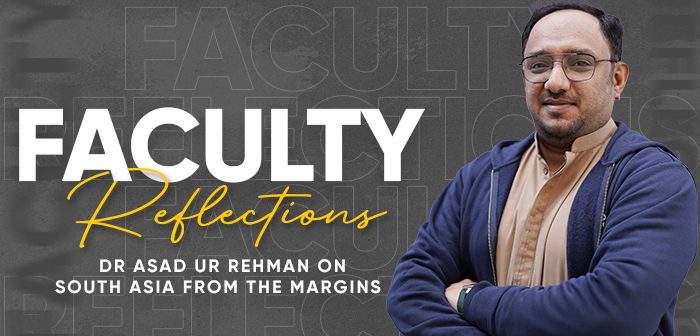Dr. Asad ur Rehman is an Assistant Professor in the Social Development and Policy program at Habib University, Karachi. With a research focus on political sociology, rural transformation, and state-society relations in South Asia, his work critically explores how marginalized communities engage with structures of power. Dr. Rehman’s scholarship is deeply rooted in ethnographic methods and interdisciplinary inquiry, making him a leading voice in rethinking development and governance from the ground up.
Read his reflection on the process of research, writing, and editing the volume.
Published by Routledge International in 2025, South Asia from the Margins: Transformations in the Political Space is the result of a four-year journey of collaboration, critical engagement, and regional dialogue. As both co-editor and contributor, I had the privilege of helping shape a volume that emerged from the 2021–2022 conference Whither Politics and Policy in South Asia: Building a Regional Perspective. This event brought together scholars from across the subcontinent to challenge national silos and reimagine South Asia’s political futures from its margins.
Unlike many edited volumes that focus narrowly on nationalism, security, or citizenship within single-country frameworks, this book takes a bold, interdisciplinary approach. It centers the geographic and social peripheries of South Asia—regions and communities often excluded from mainstream academic and policy discourse. By doing so, it resists the reification of national boundaries and opens space for more inclusive, grounded analyses.
A key motivation behind this volume was the persistent imbalance in how South Asia is represented in Western academia. Too often, “South Asia” is equated with Indian studies, sidelining countries like Pakistan, Nepal, Sri Lanka, and Bangladesh. This academic marginalization mirrors geopolitical dynamics, such as India’s promotion of BIMSTEC over SAARC, which effectively redraws the region’s contours to fit a narrower strategic vision.
Recent events—such as the tragic terrorist attacks in Pahalgam, the escalation along the India-Pakistan border, and India’s suspension of the Indus Waters Treaty—underscore the urgency of our argument: the margins of South Asia cannot be ignored. These developments reveal the deep interdependence of the region’s rivers, climates, migration routes, and histories. No strategic reconfiguration can erase these entanglements.
My own chapter, “Overviewing the Regime of Practical Citizenship in Rural Pakistan,” contributes to this broader critique by examining citizenship as a lived, negotiated experience. Drawing on ethnographic research in rural Punjab, I explore how everyday interactions with bureaucracies, political actors, and community networks shape people’s sense of belonging and access to the state. This grounded perspective challenges formalist definitions and highlights the improvisational nature of state-society relations.
What makes South Asia from the Margins especially meaningful is its methodological openness and collaborative spirit. The volume resists totalizing narratives and instead embraces the plurality of political experiences across the region. It is a product of rigorous editorial work and a shared commitment to rethinking South Asia from the ground up.
In a time when the very idea of South Asia is being contested—politically, intellectually, and cartographically—this volume offers a timely intervention. It insists on the value of looking from the margins to better understand the region’s complex realities.
Order your copy of South Asia from the Margins from Routledge and join the conversation on reshaping regional politics through inclusive, interdisciplinary scholarship.




